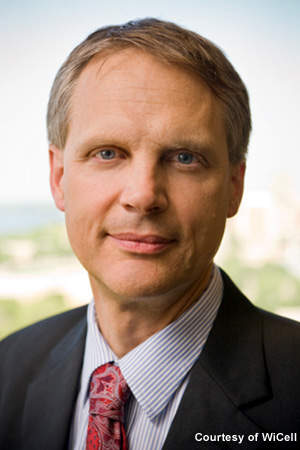
It was approximately one year ago that President Barack Obama lifted former president George W Bush’s ban on embryonic stem cell research. Earlier this year, legislation (The Stem Cell Research Advancement Act, H.R. 4808) was introduced to amend the Public Health Service Act, which would codify Obama’s executive authorising research on human stem cells (including embryonic stem cells). Since Obama reversed the existing limits, the National Institutes of Health (NIH) has approved 43 stem cell lines (funding was restricted to 21 cell lines by Bush), demonstrating the extent to which it has impacted the potential advancement of stem cell research.
Codification means the industry will benefit from cell line diversity and investment as a result of renewed stability in the future of stem cell research. Having the confidence to invest and move forward is what Dr Mark A Magnuson of the Vanderbilt Center for Stem Cell Biology has been waiting for after progress was thrown off for six to nine months. “An issue with the new Obama policy is that it has been disruptive,” says Magnuson. “Even though we now have access to many new lines, which is something we needed, it’s also had the negative consequence of making it impossible to know with certainty whether we could continue working on the Bush-era cell lines.”
Codification means confidence
The confidence that codification will bring to the industry is crucial to successful industry development according to David Welch, senior manager of market development for primary and stem cell systems at biotechnology tool company Life Technologies. “The change in legislation will allow pharmaceutical companies to enter this field with more confidence. They will benefit from the greater amount of research that will undoubtedly be going on in the public domain,” says Welch.
Welch anticipates more use of embryonic stem cells (ESCs) and ESC derivatives in the drug discovery arena and more effective treatments for disease through researchers’ access to a greater variety of human embryonic stem cell (hESC) cell lines. “This should accelerate the development of safer, more effective treatments for diseases such as cancer, diabetes, Alzheimer’s and Parkinson’s,” says Welch.
According to Derek Hei, director at Waisman Clinical BioManufacturing Facility (WCBF), University of Wisconsin, cell line diversity is critical to the WCBF. It wants to advance hESCs into clinical application for three main reasons: to understand the impact of cell genetic characteristics on cell behaviour; to understand ethnic and HLA diversity for potential therapeutic applications and to understand diversity in the cell line derivation method. “We need to understand cell line genetic diversity and associated characteristics in order to select appropriate cell lines for specific clinical applications,” says Hei.
How well do you really know your competitors?
Access the most comprehensive Company Profiles on the market, powered by GlobalData. Save hours of research. Gain competitive edge.

Thank you!
Your download email will arrive shortly
Not ready to buy yet? Download a free sample
We are confident about the unique quality of our Company Profiles. However, we want you to make the most beneficial decision for your business, so we offer a free sample that you can download by submitting the below form
By GlobalDataNIH Stem Cell approval upheaval
A further issue contributing to the instability and lack of confidence in the future of stem cell research has been the consequences of the NIH’s approval guidelines introduced last July. As the previously approved lines under the Bush Administration were not grandfathered for federal funding, applications had to be submitted for reassessment. The H9 was one of the approved lines. It accounted for 40% of all National Stem Cell Bank (NSCB) orders. For Dr Magnuson, waiting for the re-approval of lines in use, including the widely-used H9 cell line, caused so much uncertainty that he put his work on hold until this line was reapproved. “Some of the things we do require genetic manipulation and the effort involved is substantial, so it became pointless to proceed until we were confident that we could use this particular line in future studies,” explains Magnuson.
Stem Cell Distribution difficulties
While an expanded range of stem cell lines means greater research possibilities, a major challenge is set to be accessing the cells in the first place. In 2005 the NSCB (established to distribute the Bush-approved lines to labs around the country) closed down. Many, including Erik Forsberg, executive director of the WiCell Research Institute, believe that a federally backed distribution system is needed to standardise the quality of the cell lines, support the delivery process and reduce costs to recipients.
“Many organisations are listing hES cell lines on the NIH Stem Cell Registry but are finding that banking, testing and shipping these cells, as well as finalising material transfer agreements and supporting cell line recipients, is a time consuming and expensive process,” says Forsberg.
And while the executive order will open up possibilities for newer labs, Derek Hei says he believes these access issues could impact on them the most. “Without access to a good supply of high quality, well characterised cells, labs can end up getting poor quality cells that have a huge negative impact on the quality of their research” says Hei.
Budget and breakthroughs
Despite these challenges, as Geron’s first FDA-approved study of hESC-based therapy on humans with spinal cord injury demonstrates, progress could potentially advance fast and lead to more effective medical treatments. For Mike Castle, Delaware’s lone member in the House of Representatives, this is the driver for codifying the Stem Cell Advancement Act. “Stem cell research holds great promise for alleviating the suffering of the 100 million American patients living with devastating diseases for which there are no good treatment or cures,” says Castle.
For 2011, a budget of $32.1bn is to be awarded to the NIH, including over $1bn focused directly on stem-cell research and ($126 on human embryonic stem cells), $143 for autism and over $6bn for cancer. WiCell is actively pursuing banking and distribution of disease model hPS cell lines believing this is where funding will be directed. “Since hES and induced pluripotent stem (iPS) cell lines that have genotypes associated with cancer and autism are growing in number and availability, I expect that a larger portion of the HHS funding for these diseases will go towards the use of these ‘disease-model’ human pluripotent stem (hPS) cell lines to understand the etiology of the diseases and for drug screening,” explains Forsberg.
Stem cell challenges
The full extent of challenges facing this new era of stem cell research remain to be seen. On the surface, however, one of the biggest issues to overcome will be that of safety, particularly regarding the stem-cell driven product in the treatment of people. “I think there needs to be some honest dialogue about the timeframes involved,” Magnusun says. “While I firmly believe in the promise of stem cells, much of the field has been hyped up. It may take years for new stem cell therapies to become a reality.”
For Forsberg the biggest challenges will also relate to understanding the science and indentifying potential applications of hPS cells. “New knowledge will drive innovated uses for these cells and inevitably new funding opportunities,” Forsberg says.
Despite the problems caused through waiting for NIH re-approval, the closure of the NSCB, distribution complications and safety concerns, breakthroughs are occurring and with codification of The Stem Cell Research Advancement Act, a productive and smoother future for stem cells is anticipated. As Forsberg says: “R&D efforts both in academia and industry should resume at a furious pace.”







